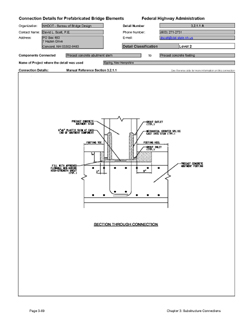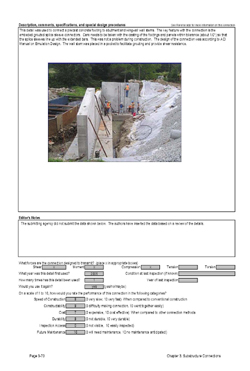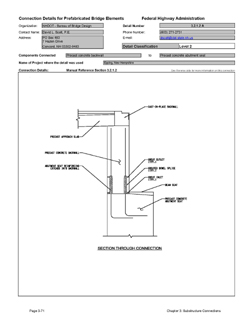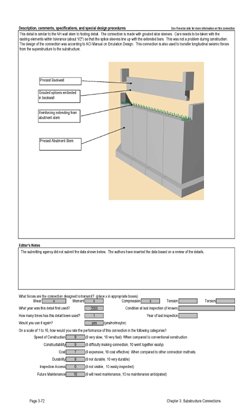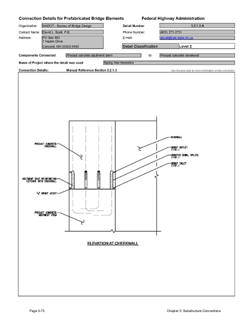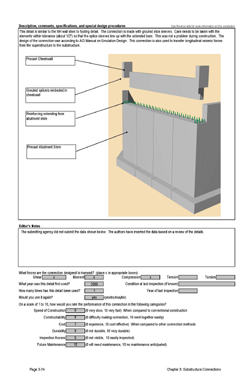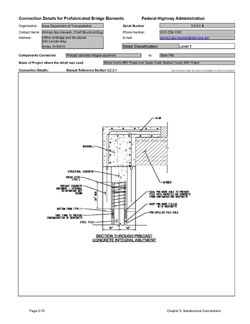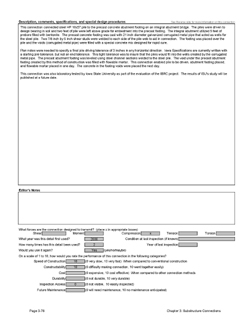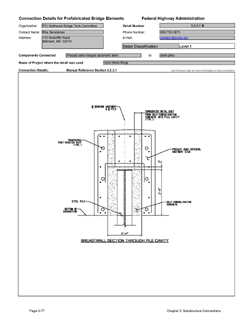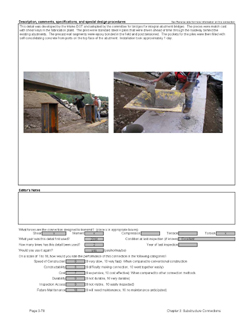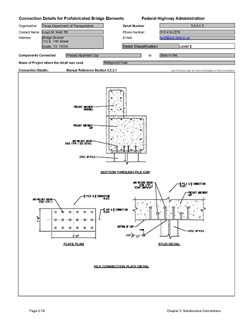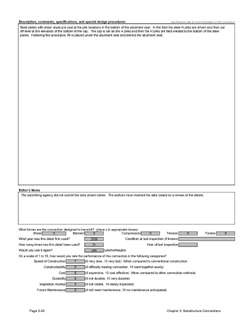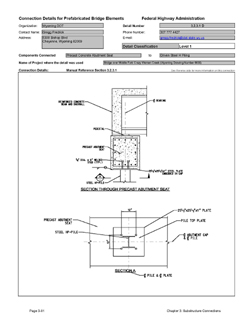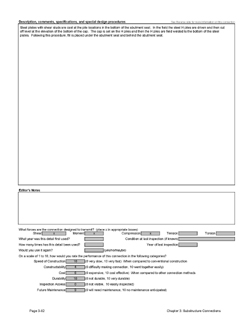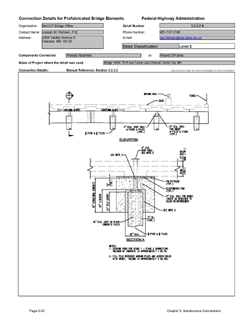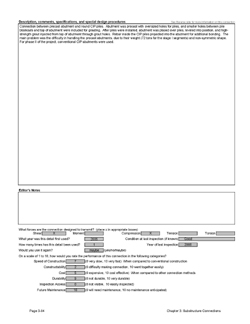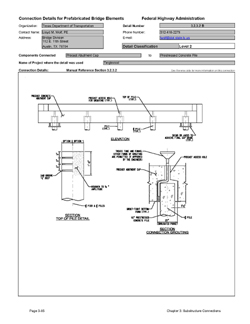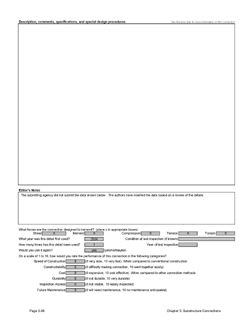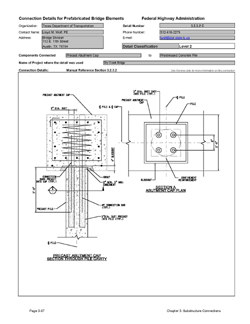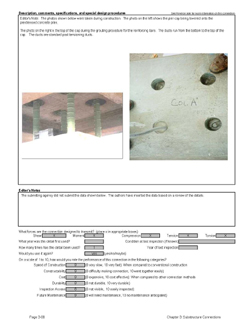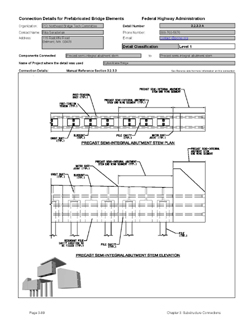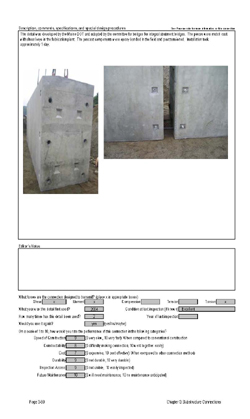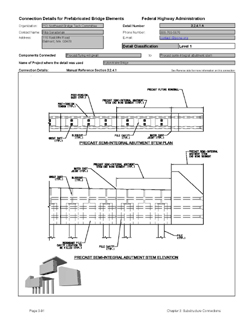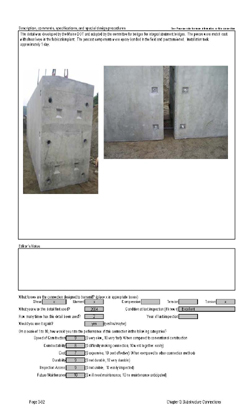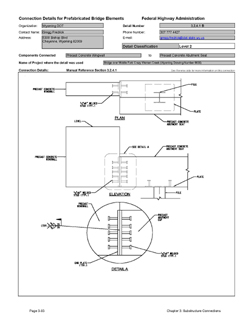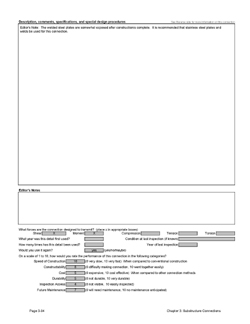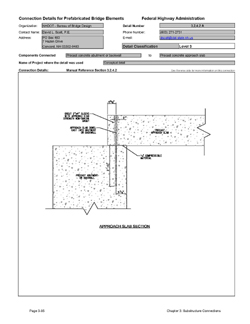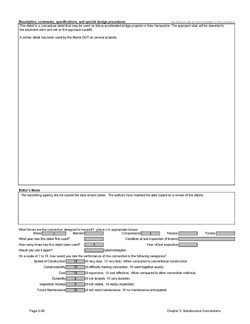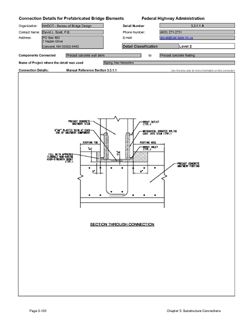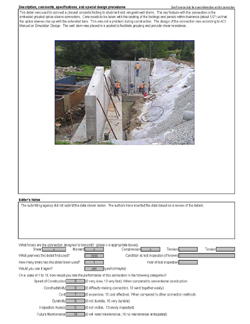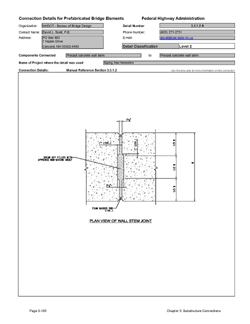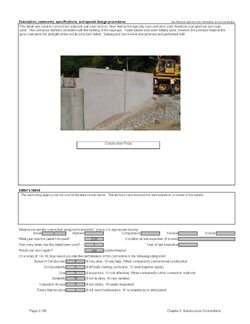| << Previous | Contents | Next >> |
Connection Details for PBES
Chapter 3 - Substructure Connections
3.2 Abutment Systems
Most states have not attempted prefabricated abutment designs; however several have had very successful projects. Abutment construction can be a slow process; therefore prefabrication offers an opportunity to greatly reduce the overall project time. There are different types of abutments in use today in the United States. Integral and semi-integral abutments are gaining popularity over conventional free standing wall abutments. Both types of abutments have been built using prefabricated elements; therefore designers can detail prefabricated abutments for virtually any abutment configuration that is in use today.
The spread footings and other substructure components for the Epping Bridge in New Hampshire were fabricated in segments as determined by the contractor and precaster to facilitate shipping and handling, and were standardized to reduce fabrication costs. The precaster used a template in the plant fabrication to ensure adequate tolerances between the abutments, wingwalls, and footing segments. The contractor developed the assembly plan.
Backfilling Options:All abutments require some level of filling. Earth placement can be time consuming; however there are some methods that can be employed to reduce filling times.
One method is to use flowable fill for the backfill soils. Flowable fill is a mixture of sand, water and minor amounts of cement. It can be installed without compaction since it is in a semi-liquid state when placed. Therefore, flowable fill can dramatically reduce the amount of time to complete the backfilling. The only disadvantages are that the backfill area needs to be contained or formed so the fill does not spill out, and the material cost is somewhat higher than granular backfills. Designers should also note that flowable fills have different soil properties than compacted fill, which will affect the design of the abutments. The fill generally has a slightly higher unit weight when placed (approximately 125 pcf). Once set, the fill has very high passive pressure resistance since it is essentially a concrete product. For this reason, it should not be used behind integral abutments where abutment movement could generate large passive pressures against the fill.
Another method for reducing backfilling times is to use foam block fill materials. These blocks are normally made with expanded polystyrene. They are very lightweight and easy to install. The blocks are simply stacked behind the abutment. This system can greatly reduce the forces acting on the abutment stems; however there is also a reduction in overturning resistance on the top of the footings. The disadvantages to this system is that there needs to be a certain amount of fill placed over the blocks to support wheel loads, the system can float out of the ground if there is a high water table, the system needs to be waterproofed against certain types of spills, and they can be expensive when compared to conventional granular fills.
On an accelerated construction project, it may be preferable to allow one or both of these backfilling methods in combination with conventional granular backfill. The contractor can then choose whether or not to use the compacted granular fill or one of these methods.
3.2.1 Cantilever Wall Abutments
Cantilever abutments serve two purposes. They need to retain the soils behind the ends of the bridge and they need to support the bridge superstructure. Some wall abutments are referred to as stub abutments. These abutments are made as short as possible and are installed at the top of fill embankments. Stub abutments usually only retain soils that are slightly higher than the superstructure thickness. Stub abutments can be very economical; however they tend to increase the length of the end spans. Other wall abutments can be much taller and are often constructed to the full height of the crossing. Full height abutments are more difficult to build; however they tend to reduce the length of the end spans.
The New Hampshire DOT has constructed one prefabricated bridge in Epping, New Hampshire, using precast concrete wall abutments. The abutments were designed as conventional cast-in-place concrete abutments; however the construction joints were replaced with connections that used grouted reinforcing splice couplers. Full height abutments were used to reduce the main span length. Both abutments were constructed in less than three (3) days once the excavation was complete. The details on the Epping Bridge can easily be used for any bridge since the connections simply emulate a cast-in-place concrete construction joint. See the Case Study of this bridge in Appendix D for more information on this bridge.
3.2.1.1 Precast Abutment Stem to Precast Footing Connection
Spread footings provide significant speed and simplicity to bridge construction when soil conditions permit their use. At least one state has built a prefabricated abutment wall structure that was supported on precast concrete footings. This was the Epping Bridge in New Hampshire. The connection was made using grouted reinforcing splice couplers. The splice was set in a recessed pocket in the footing. This pocket may not be necessary for shear; however it was used to provide head for flowing the grout into the joint. The same precast producer constructed both elements; therefore the fit-up of the couplers was not a problem.
3.2.1.2 Precast Backwall to Abutment Stem Connection
Backwalls are primarily used to support the soil directly behind the beam ends. Often they are also used to support concrete approach slabs.
The connection of a precast concrete backwall to a precast concrete abutment stem can be made in a similar fashion as the stem to footing connection described in Section 3.2.1.1 above. Grouted reinforcing splice couplers can be used to provide a moment connection for these elements. Other typical connection methods can also be used for this element. See Section 1.4 for more information on connection options.
3.2.1.3 Precast Breastwall (cheekwall) to Abutment Stem Connections
Breastwalls or cheekwalls are often used as a decorative element to conceal the ends of the beams at the corners of the abutments. Some states used these elements to restrain the superstructure from seismic forces.
The connection of a precast concrete breastwall to a precast concrete abutment stem can be made in a similar fashion as the stem to footing connection described in Section 3.2.1.1 above. Grouted reinforcing splice couplers can be used to provide a moment connection for these elements. Other typical connection methods can also be used for this element. See Section 1.4 for more information on connection options.
3.2.2 Spill-through Abutments
The intent of spill-through abutments is to reduce the amount of soil pressure on the abutment by installing large voids in the stem. Spillthrough abutments are similar to piers except the majority of the structure is below grade. Information in Section 3.1 can be used for prefabricated bridges with spill-through abutments.
3.2.3 Precast Concrete Integral Abutments
Integral abutments get their name because the abutment structure is made integral with the superstructure elements. There are two major advantages for the use of integral abutments:
- Integral abutments do not normally have deck joints. This eliminates one of the most common deterioration areas on bridges.
- Integral abutments transfer the soil forces into the bridge superstructure. The superstructure has tremendous available capacity; therefore this usually has no affect on the superstructure design. Integral abutments are normally supported on a single row of piles that are designed to move with the bridge during thermal cycles. The result of this approach is that the abutment does not need a spread footing or multiple rows of piles to resist the overturning soil forces.
There are two types of integral abutments. The most common is a fully integral abutment where the connection to the superstructure is a full moment connection. The second type of integral abutment is a semiintegral abutment where the moment connection is replaced with a pinned connection that allows rotation of the superstructure with respect to the substructure. See Section 2.5 for information on the connection of the superstructure to integral abutments.
3.2.3.1 Connection Between Abutment Stem or Cap and Steel Piles
There are several options for connecting precast concrete abutment stems or caps to steel piles. Several states have cast the abutment caps with anchored steel plates that can be field welded to the piles after they are cut off to the proper elevation.
Other states embed the piles in large pockets in the precast abutment stem element. After placement over the piles, the void is filled with non-shrink grout or concrete.
3.2.3.2 Connection Between Abutment Stem or Cap and Concrete Piles
There are several options for connecting a precast concrete abutment stem or cap to concrete piles. The first method is to drill and grout reinforcing bars into the top of the pile, and insert these bars into grouted tube couplers in the abutment stem element.
Another option is to embed the piles into large pockets in the precast abutment stem element. After placement over the piles, the void is filled with non-shrink grout or concrete.
3.2.3.3 Connection Between Adjacent Abutment Stems or Caps
In some cases, the integral abutment stem or cap will need to be manufactured in several pieces due to shipping and crane limitations. The Maine DOT built several prefabricated integral abutment bridges with two abutment pieces that were match cast and post-tensioned in the field.
Small closure pours could also be used for this connection since the curing of the closure pour concrete would most likely not restrict the continuation of the bridge construction.
3.2.4 Miscellaneous Abutment Connections
3.2.4.1 Flying Wingwalls
Flying wingwalls are small retaining walls that project from abutment stems. These walls do not have footings or any vertical support. The soil forces are transferred to the abutment stem by means of a vertical moment connection.
Several states have used prefabricated flying wingwalls. Wyoming DOT has used welded plate connection. Plates were embedded and anchored in the elements. During installation, the plates were field welded together. Maine DOT used a match cast piece combined with post-tensioning. This was done because the abutments were constructed with two abutment stem elements in order to reduce shipping and lifting weight. The addition of the flying wingwall pieces to the process of constructing the abutments was not significant.
3.2.4.2 Approach Slabs
Approach slabs are used to prevent the "bump at the end of the bridge" that results from settlement of the approach roadway fills directly behind the abutments. The size of approach slabs vary from state to state. Many states use nominal length approach slabs of approximately 10 to 15 feet in length. These slabs are designed to span from the rear face of the abutment to the roadway approach embankment.
The connection of the approach slab to the abutment is often detailed as pinned connection with minimal reinforcing steel. Maine DOT has prefabricated approach slabs for several bridges. The Maine details are similar to the details shown in this manual from the New Hampshire DOT. The slabs were simply pinned to the abutments by means of simple dowel bars. The other end of the slab was simply set on compacted fill.
3.2.5 Grade Control and Tolerances
As with pier systems, the construction of prefabricated abutment elements can lead to problems with grade and horizontal control. Minor grade and alignment problems can be corrected in other connections above the abutment (haunches in deck pour forming for example); however it is always desirable to make adjustment for grade as the construction progresses. Some of the connections shown in the manual have grout beds or cast-in-place closure pours which can be used to make minor adjustment to grade. This is commonly done by means of small shim packs that are placed between the elements being connected. Often these shims are made of polymer sheets, and are left in place in the finished structure. Steel shims should be avoided because they would represent a hard point that may attract stresses as the structure is loaded, which could lead to spalling of the precast elements.
The use of mechanical connectors requires more careful attention to tolerances in the precast process. If grouted reinforcing splice couplers are used between two precast elements, the designer can specify that the connections be dry connected in the shop to ensure proper fit.
See Section 1.7 for more discussion on tolerances.
3.2.6 Evaluation of Performance and Long Term Durability of Prefabricated Abutment Systems
Generally the abutment connections shown in the manual are relatively new; therefore do not have a significant record of performance. The details used in the New Hampshire Epping Bridge are essentially the same as the Florida Edison Bridge, which has performed very well. It is expected that all of these details will perform very well over time.
Several details included in this manual consist of exposed welded plate connections. These connections should either be used in non-corrosive environments, or made with stainless steel plates. The use of stainless steel connection plates has become common in precast parking garage structures.
Owners should consider how aggressive the environment will be where these connections will be used and select the materials accordingly like stainless steel, galvanized connections, or coated connections. After welding, proper repair of corrosion protection is required. Galvanized or coated elements will require future periodic maintenance.
3.2.7 Estimated Construction Time for Connections
Exact timelines for construction are dependent on a number of factors including site access, traffic control, weather, crane locations and storage areas. It is possible to make reasonable estimates on construction time for the various systems discussed in this section.
Table 3.2.7-1 contains approximate installation times for the various abutment systems included in this section:
| System | Minimum Installation Time | Comments |
|---|---|---|
| Grouted Reinforcing Splice Coupler Connections | 1 Day or less | This includes bracing and grouting. |
| Blockout closure pour connections | 1-2 Days | Two days are required for the closure pour concrete (high early strength) to attain at least enough strength to allow for construction to progress. |
| Post-Tensioning Systems | 3 Days | This includes connecting the elements with epoxy, placement of the post-tensioning strand or rod, and grouting of the ducts. |
3.2.8 Recommendations for Improvements to Current Practices
To date, grouted connections and closure pour systems on precast abutments have been very successful. Based on the performance of pier systems using similar connections, it can be assumed that prefabricated abutment connection will also be durable.
3.2.9 Connection Detail Data Sheets for Abutment Systems
The following pages contain data sheets for the various prefabricated abutment systems. This information was primarily gathered from agencies that have developed and used the systems. Most data in the sheets were provided by the owner agency; the authors added text when an agency did not supply all requested information. The owner agencies also provide a comparative classification rating.
Each connection detail data sheet is presented in a two-page format. Users of this Manual can simply remove and copy a data sheet for use in developing a system for a particular project. These sheets are meant to give users a basic understanding of each connection that can be used during the type study phase of a project. The data sheets are not meant to be comprehensive, but do convey the component make-up of the detail, how it is meant to function, and provide some background on its field application. Users will need to investigate each connection further, consider site-specific conditions, and apply sound engineering judgment during design.
The key information provided for each connection is as follows:
- Name of the organization that supplied the detail
- Contact person at the organization
- Detail Classification Level
- Level 1
This is the highest classification level that is generally assigned to connections that have either been used on multiple projects or have become standard practice by at least one owner agency. It typically represents details that are practical to build and will perform adequately. - Level 2
This classification is for details that have been used only once and were found to be practical to build and have performed adequately. - Level 3
This classification is for details that are either experimental or conceptual. Details are included in this Manual that have been researched in laboratories, but to the knowledge of the authors, have not been put into practical use on a bridge. Also included in this classification are conceptual details that have not been studied in the laboratory, but are thought to be practical and useful.
- Level 1
- Components connected
- Name of project where the detail was used
- Manual Reference Section The section(s) of this Manual applicable to the particular detail shown.
- Connection Details
- Description, comments, specifications and special design procedures
- Forces that the connection is designed to transmit
- Information on the use of the connection (including inspection ratings)
- A performance evaluation of the connection rated by the submitting agency
Click images below to enlarge
Detail 3.2.1.1A
Detail 3.2.1.2A
Detail 3.2.1.3A
Detail 3.2.3.1A
Detail 3.2.3.1B
Detail 3.2.3.1C
Detail 3.2.3.1D
Detail 3.2.3.2A
Detail 3.2.3.2B
Detail 3.2.3.2C
Detail 3.2.3.3A
Detail 3.2.4.1A
Detail 3.2.4.1B
Detail 3.2.4.2A
3.3 Wingwall and Retaining Wall Systems
Wingwalls and retaining walls are sometimes referred to as earth retaining systems. There are many different types of systems for constructing earth retaining walls. The most common types of walls include:
- Concrete Cantilever
- Concrete Gravity
- Mechanically Stabilized Earth
- Prefabricated Modular
- Anchored
- Cantilever Sheeting and Soldier Pile
The AASHTO LRFD Specifications [1] includes details about each one of these walls. This section will include information on prefabrication of retaining wall systems and how they can be used in accelerated construction projects.
Some of the systems shown in this section are proprietary; however in most cases, there are multiple manufacturers that can produce similar walls. Some states allow multiple wall systems for larger wall projects by bidding the walls as a design-build product, where the manufacturer designs the wall based on the constraints of the site.
3.3.1 Cantilever Walls
Conventional cantilever walls are normally comprised of a reinforced concrete footing connected to a reinforced concrete stem. These wall types are common for wingwalls on bridges that are relatively short in both length and height.
3.3.1.1 Precast Wall Stem to Precast Footing Connection
The state of New Hampshire has developed a prefabricated version of a conventional cantilever wall system by using emulation techniques (see Section 1.4.2.1 for more information on emulation). The typical construction joint between the wall stem and the footing is replaced by a grouted reinforcing splice coupler connection. The New Hampshire system also includes precast concrete footings (see Section 3.2.1.1 and Chapter 4 for more information on precast footings).
This system was used on a bridge in Epping, New Hampshire, where the entire bridge was constructed in only eight days. The wingwall construction took approximately one (1) day. The data sheet detail in this section is for the Epping precast abutment stem to precast footing connection, which also works for a precast cantilever wall to precast footing connection.
3.3.1.2 Precast Wall Stem to Precast Wall Stem Connection
The AASHTO LRFD Specifications [1] require that retaining walls be constructed with contraction joints spaced at a maximum of 30 feet and expansion joints spaced at no more than 90 feet. The specification goes on to require that the joints be filled with an approved filler material to ensure the proper function of the joint.
Contraction joints are used to allow the concrete to shrink during curing and to contract with temperature changes. Contraction joints differ from construction joints in that they do not have reinforcing passing through the joint. Expansion joints are used to allow the concrete to shrink and to allow thermal expansion of the wall. Expansion joints also do not have reinforcing passing through them; however the joint must be filled with a compressible material.
Some states detail the contraction joints with shear keys to provide interaction with adjacent wall panels. Other states simply have a flat joint without shear keys. The New Hampshire DOT details include shear keys; therefore a grouted shear key configuration was used. The grout was placed after the wall panels were set and connected to the footings. The Epping Bridge did not require expansion joints due to the length of the walls; however they have developed details for longer walls where the expansion joints would be filled with expanded foam to allow for thermal expansion. Information on this detail can be found in the PCI Northeast document entitled "Guidelines for Accelerated Bridge Construction Using Precast/Prestressed Concrete Components" [44].
3.3.2 Modular Precast Wall Systems
Modular precast concrete wall systems are walls that are made up of prefabricated elements that are joined in different ways to create a wall system.
There are two distinct types of prefabricated wall systems that are primarily in use today. There are other systems in use and more in development. All of these wall systems include prefabricated elements; therefore they are well suited for prefabricated bridge projects.
3.3.2.1 Mechanically Stabilized Earth Systems (MSE)
MSE systems use thin prefabricated wall panels that are connected to earth anchoring devices. These devices engage the soil mass behind the wall face to create a soil mass gravity wall. The construction of these walls can progress rapidly because the system is built while the soil is being placed behind the wall; thereby combining two processes into one.
MSE walls are proprietary; however there are several manufacturers that make this type of system. Most states have standard details or approved wall products; therefore individual details from each state are not presented in this manual. Figure 3.3.2.1-1 depicts a typical wall section for a mechanically stabilized earth wall. Designers should contact each state to determine which wall systems are allowed for use.
Figure 3.3.2.1-1 Typical MSE Wall Details
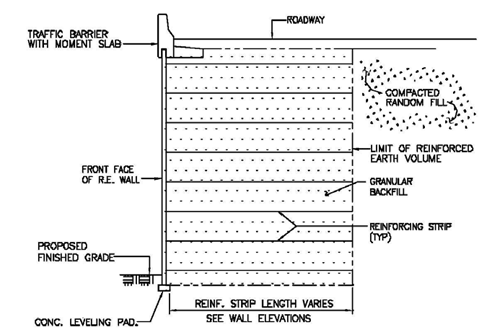
3.3.2.2 Modular Block Systems
Modular block retaining walls are a form of gravity retaining wall in which the cast-in-place concrete is replaced by modular reinforced concrete modules that interlock to form a wall system. The system resists soil forces by the mass of the wall and sometimes by the mass of soil placed within voids in the blocks.
As with MSE systems, modular block walls are normally proprietary. Many states have approved product lists for these wall systems; therefore individual details from each state are not presented in this manual. Figure 3.3.2.2-1 depicts a typical wall section for a modular block wall. Designers should contact each state to determine which wall systems are allowed for use.
Figure 3.3.2.2-1 Modular Block Wall Example
(T-WALL®, Courtesy of the Neel Company)
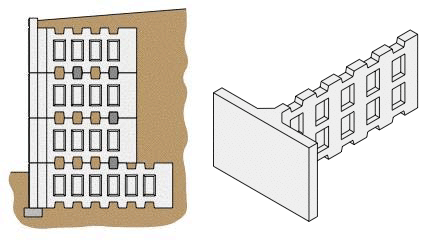
3.3.3 Tolerances
In cases where wingwalls are directly attached to the bridge structure the same tolerances for the bridge should be followed for the wingwall. Most retaining walls are constructed away from the roadway and therefore do not need to be constructed to a tight tolerance. Each individual wall manufacturer has developed wall construction tolerances that should be followed during the installation. These tolerances ensure the proper fit of the individual elements.
3.3.4 Evaluation of Performance and Long Term Durability of Prefabricated Wall Systems
There is a long history of prefabricated wall systems in the United States. The modular retaining wall systems that are constructed with high quality precast concrete have performed very well. Most performance issues with wall systems can be attributed to problems with either the supporting soils or the backfill soils. The use of proper drainage systems for backfill soils is also critical for the long term performance of any wall system. Proper compaction of backfill soils also plays an important role in performance.
3.3.5 Estimated Construction Time for Connections
Exact timelines for construction are dependent on a number of factors including site access, traffic control, weather, crane locations and storage areas. It is possible to make reasonable estimates on construction time for the various systems discussed in this section. Since retaining walls and wingwalls can vary in size, the values given are for a typical bridge wingwall that is approximately 50 feet long and approximately 15 feet tall.
Table 3.3.5-1 contains approximate installation times for the various wall systems included in this section:
| System | Minimum Installation Time | Comments |
|---|---|---|
| Precast Cantilever Wall | 3 Days | This includes bracing, grouting and backfilling. |
| MSE Wall System | 4-Days | This includes a concrete leveling pad, placement and backfilling. |
| Modular Block Systems | 4 Days | This includes a concrete leveling pad, placement and backfilling. |
3.3.6 Recommendations for Improvements to Current Practices
Many states use prefabricated wall systems. The construction of retaining walls can be the critical path to an accelerated construction project. With many highways being widened within limited right of way, it is common for designers to detail long retaining walls along the edge of roadway where earth embankments exist. These walls can be over a mile long and therefore represent the most significant structure on the project.
Designers often detail only one wall system for a given site. An option that could be considered is to allow multiple wall types at a given location so contractors can choose the most efficient system for construction. In this case the wall is bid as a lump sum item. Designers need to carefully detail the limits of payment for a lump sum wall bid, which should include the backfill soils. This is required because the backfill soils are an integral portion of any wall system (see Section 3.2 for backfilling options).
3.3.7 Connection Detail Data Sheets for Wingwall and Retaining Wall Systems
The following pages contain data sheets for various prefabricated wingwall and retaining wall systems. This information was primarily gathered from agencies that have developed and used the systems. Some systems were obtained from manufacturers and industry groups. Most data in the sheets were provided by the owner agency; the authors added text when an agency did not supply all requested information. The owner agencies also provide a comparative classification rating.
Each connection detail data sheet is presented in a two-page format. Users of this Manual can simply remove and copy a data sheet for use in developing a system for a particular project. These sheets are meant to give users a basic understanding of each connection that can be used during the type study phase of a project. The data sheets are not meant to be comprehensive, but do convey the component make-up of the detail, how it is meant to function, and provide some background on its field application. Users will need to investigate each connection further, consider site-specific conditions, and apply sound engineering judgment during design.
The key information provided for each connection is as follows:
- Name of the organization that supplied the detail
- Contact person at the organization
- Detail Classification Level
- Level 1
This is the highest classification level that is generally assigned to connections that have either been used on multiple projects or have become standard practice by at least one owner agency. It typically represents details that are practical to build and will perform adequately. - Level 2
This classification is for details that have been used only once and were found to be practical to build and have performed adequately. - Level 3
This classification is for details that are either experimental or conceptual. Details are included in this Manual that have been researched in laboratories, but to the knowledge of the authors, have not been put into practical use on a bridge. Also included in this classification are conceptual details that have not been studied in the laboratory, but are thought to be practical and useful.
- Level 1
- Components connected
- Name of project where the detail was used
- Manual Reference Section The section(s) of this Manual applicable to the particular detail shown.
- Connection Details
- Description, comments, specifications and special design procedures
- Forces that the connection is designed to transmit
- Information on the use of the connection (including inspection ratings)
- A performance evaluation of the connection rated by the submitting agency
Click images below to enlarge
Detail 3.3.1.1A
Detail 3.3.1.2A
| << Previous | Contents | Next >> |


